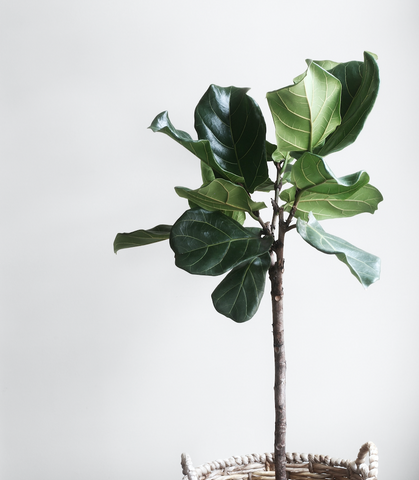Introduction
The Fiddle Leaf Fig, also known as Ficus Lyrata, has become a popular indoor plant in recent years. With its large, glossy leaves and striking appearance, it's no wonder why so many people have fallen in love with this plant. However, despite its popularity, the Fiddle Leaf Fig can be a bit finicky when it comes to care. In order to keep your plant healthy and thriving, it's important to know the best practices for caring for it. In this ultimate guide, we'll cover everything you need to know about caring for your Fiddle Leaf Fig.
Best Practices for Fiddle Leaf Fig Care:
Lighting:
Let's talk about the natural habitat of fiddle leaf figs. These plants are native to the tropical rainforests of West Africa, where they grow under the canopy of larger trees. As such, they are adapted to thrive in bright, indirect light.
Indoors, it's important to try and replicate this type of lighting as much as possible. Ideally, you'll want to place your fiddle leaf fig near a window that receives bright, filtered light. This means that the light should be diffused and not direct. Direct sunlight can scorch the leaves of your plant and cause irreversible damage.
If your fiddle leaf fig isn't getting enough light, you may notice that its leaves are turning yellow and dropping off. On the other hand, if it's getting too much light, you may see brown spots or burnt edges on the leaves.
So, how do you strike the right balance? The best way is to observe your plant and adjust the lighting accordingly. If you notice that the leaves are yellowing or dropping off, try moving it closer to a window or adding a sheer curtain to filter the light. If you notice burnt edges or brown spots on the leaves, move it further away from the window or add a thicker curtain to block more of the light.
It's also worth noting that fiddle leaf figs can adapt to different lighting conditions over time. So, if you need to move your plant to a different spot, it may take a few weeks for it to adjust to the new lighting.
In addition to natural light, you can also supplement your fiddle leaf fig with an artificial light LED Grow Light. This can be especially helpful if you don't have access to a window that receives bright, filtered light. You can use a grow light to provide your plant with the right amount and type of light it needs to thrive. Just be sure to place the grow light at the right distance from the plant and follow the manufacturer's instructions for optimal results.
Watering:
Fiddle Leaf Figs require a moderate amount of water, similar to other indoor plants. These plants are native to tropical rainforests, where they receive consistent but not excessive rainfall. As indoor plants, they prefer a similar watering schedule to their natural habitat.
So, how often should you water your fiddle leaf fig?
In general, it's best to wait until the top 3-5cm of soil is dry before watering again. This will prevent overwatering and allow the roots to receive the proper amount of oxygen.
When watering your fiddle leaf fig, it's important to thoroughly soak the soil. This means pouring water slowly and steadily until water runs out of the drainage holes at the bottom of the pot. Then, allow the excess water to drain away completely before placing the plant back in its spot.
It's worth noting that the frequency of watering may change depending on the season. In the warmer months, your fiddle leaf fig may require more frequent watering as it uses more energy to grow. In the cooler months, it may require less watering as it's in a period of dormancy.
It's also important to pay attention to the leaves of your fiddle leaf fig. If you notice the leaves starting to droop, this may be a sign that your plant needs water. However, if the leaves are yellowing or falling off, this may be a sign of overwatering. In this case, it's important to adjust your watering schedule and allow the soil to dry out before watering again. Paying attention to the leaves and adjusting your watering schedule accordingly will help ensure your fiddle leaf fig stays healthy and happy. Happy watering!
Fertilisation:
In terms of fertilising, fiddle leaf figs don't require frequent feedings. In fact, too much fertiliser can actually harm the plant. It's best to fertilise your fiddle leaf fig once a month during the growing season (typically spring and summer), using a balanced, water-soluble fertiliser.
It's also important to note that fiddle leaf figs are sensitive to salt buildup in the soil. Over time, fertiliser can leave behind excess salt in the soil, which can harm the roots of the plant. To prevent this, it's important to flush the soil every few months. Simply water your fiddle leaf fig thoroughly, allowing the water to flow through the soil and out of the drainage holes.

Pruning:
Pruning helps to shape the plant and encourages new growth. It can also prevent the plant from becoming too leggy or top-heavy, which can make it more prone to tipping over.
When pruning your fiddle leaf fig, start by identifying any dead, damaged, or diseased leaves. Use a pair of sharp, clean pruning shears to make a clean cut just above the leaf node (the point where the leaf meets the stem).
Next, take a step back and evaluate the shape of your plant. Are there any branches that are growing in an undesirable direction or causing the plant to become unbalanced? If so, you can prune these back as well. It's important to make cuts at a 45-degree angle, just above a leaf node, to promote new growth.
If you want to encourage bushier growth, you can also prune the tips of the branches. This will stimulate new growth at the base of the plant, creating a fuller and more compact shape. Just be sure not to remove more than 30% of the plant at any one time, as this can be stressful for the plant and slow its growth.
Lastly, don't be afraid to experiment and get creative with your pruning! Fiddle leaf figs are very forgiving plants and can handle a variety of pruning styles. Whether you want a tall and tree-like shape or a shorter and bushier plant, pruning can help you achieve your desired look.
Repotting:
Repot your plant every 1-2 years, or when it has outgrown its current container. When it comes to repotting your fiddle leaf fig, it's important to choose a plant pot that is only slightly larger than the current pot. This will prevent the soil from retaining too much moisture, which can lead to root rot. It's also important to choose a pot with drainage holes to allow excess water to drain away.
Propagation:
First of all, it's important to choose a healthy and mature fiddle leaf fig plant for propagation. You'll want a plant that is at least a few years old and has several healthy leaves and branches.
There are two main methods of propagating fiddle leaf figs: stem cuttings and air layering. Stem cuttings
To propagate your fiddle leaf fig via stem cuttings, start by selecting a healthy stem with at least 2-3 leaves. Using a sharp and clean pair of pruning shears, make a clean cut just below a leaf node. Remove any leaves from the bottom 1/3 of the stem, as this is where the roots will be forming.
Next, dip the cut end of the stem in rooting hormone powder (optional) and place it in a container filled with well-draining potting soil. Water the soil thoroughly and place the container in a warm and bright location but out of direct sunlight. Keep the soil moist but not waterlogged, and in a few weeks, you should start to see new growth indicating that the cutting has rooted successfully.
If you need a stylish propagation station, don't forget to check out our products from our collection.
Air layering
Another method of propagating fiddle leaf figs involves creating a small wound on the stem and encouraging the plant to produce roots at the wound site. This method is a bit more involved and requires a bit of patience, but it can result in a more established and robust plant.
To propagate your fiddle leaf fig via air layering, start by selecting a healthy stem and creating a small wound in the bark just below a leaf node. You can use a knife or razor blade to do this. Next, wrap a small amount of moist sphagnum moss around the wound and cover it with plastic wrap, securing it with tape.
Over the next few weeks to months, the plant should produce roots at the wound site, which can then be planted in a container filled with well-draining potting soil. Be sure to keep the moss moist during this time and monitor the progress of the roots.
Common Problems:
Brown Spots: Brown spots on the leaves can be caused by over-watering or too much direct sunlight. Adjust your watering and lighting accordingly.
Yellow Leaves: Yellow leaves can be a sign of under-watering or nutrient deficiencies. Make sure your plant is receiving enough water and fertiliser.
Leaf Drop: Leaf drop can be caused by over- or under-watering, changes in temperature or lighting, or stress from being moved or repotted.

FAQs:
Is it hard to keep a Ficus Lyrata alive?
Overall, it is not hard to keep a Fiddle Leaf Fig alive. This plant is medium-care level, but with the right information, it’ll grow great. Make sure that the light levels and watering requirements are correct for a healthy plant.
Can Fiddle Leaf Figs be grown outdoors?
Fiddle Leaf Figs could be grown outside in a very sheltered position however, they are best suited for indoor growing, as they are sensitive to temperature and light fluctuations.
Where should I place my Ficus Lyrata?
You should place your Ficus Lyrata in a bright but sheltered area, which receives bright filtered light for most of the day. Correct lighting levels will ensure strong growth and colourful leaves.
How often should I fertilise my Fiddle Leaf Fig?
You should fertilise your plant regularly, approximately every 6 weeks during the growing season. It’s best to use a broad spectrum liquid fertiliser to promote healthy leaves and roots and support fast growth.
What kind of soil should I use for my Fiddle Leaf Fig?
You should use a well-draining soil that is rich in nutrients, such as a mix of peat moss, perlite, vermiculite, and potting mix. The right soil type for your plant is a very important factor in the success and health of your plant.
Is the Ficus Lyrata pet safe?
No, Fiddle Leaf Fig is not pet safe. If ingested, this plant can be toxic to most pets, however, it is only mildly toxic and may cause symptoms such as stomach pain. It also produces a sticky white sap which can cause skin irritation.
Should I mist my ficus lyrata?
Yes, you should definitely mist Ficus Lyrata. These plants love humidity which you can create by misting or with a plant humidifier. The extra humidity replicates their natural environment and helps growth.
Conclusion:
With proper care, your Fiddle Leaf Fig can be a beautiful and healthy addition to your home. Remember to provide it with bright, indirect light, well-draining soil, and the right amount of water and fertiliser. And if you run into any problems along the way, refer back to this ultimate guide for help. Happy growing!



